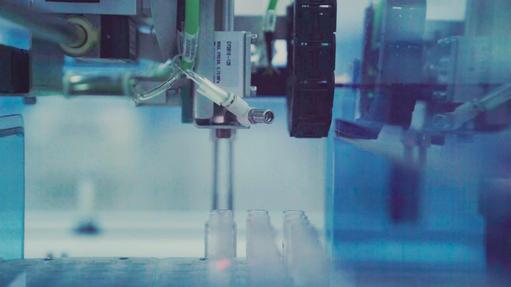- Traditional MedTechs should swiftly upgrade their human capital if they wish to keep pace with rapidly advancing technologies and changing markets
- Priority lies in aligning in-house capabilities with technology-driven strategies and the progression of healthcare systems
- Emerging technologies like AI-driven big data solutions and services are set to transform MedTech offerings
- Enterprises need to adjust to decentralised care models within evolving healthcare ecosystems
- To flourish in the next decade, MedTechs must cultivate a culture of continuous enhancement to bolster their innovation capabilities
Optimising MedTechs’ People Operations for AI and Market Changes
In today's dynamic healthcare landscape characterised by rapid technological advancements and shifting market trends, traditional MedTechs find themselves at a turning point. Maintaining competitiveness demands a proactive stance to manage change through strategic investment in human capital development. Prioritising the rejuvenation of a company’s workforce is important, as an organisation's future sustainability and success hinge on its ability to adapt and innovate. This need for transformation is driven by factors influencing healthcare, including the rise of disruptive technologies and the continuous evolution of market conditions.
In this Commentary
This Commentary stresses the need for traditional MedTech firms to modernise their people operations amid the growing influence of AI, automation, and market dynamics. It stresses aligning human capital capabilities with organisational strategies to effectively leverage technological advancements, market shifts, and evolving healthcare systems. By showcasing the transformative potential of AI-powered big data-driven solutions and services, it draws attention to the importance of empowering people to manage challenges and drive innovation that provide access to new revenue streams. Furthermore, it highlights the shift towards decentralised care, prioritising prevention, and patient-centricity, prompting enterprises to realign their internal capabilities accordingly. Addressing challenges posed by off-patent products, the Commentary advocates a proactive approach in equipping workforces with essential skills and a mindset conducive to excelling in an era of heightened automation and efficiency. Lastly, it underscores refocusing company operations on value creation while fostering a culture of continuous improvement and innovation, guiding MedTechs to maintain their competitive edge in the evolving healthcare ecosystem.
Technological Advancements and Market Dynamics
The healthcare industry is undergoing a transformation fuelled by rapid technological advancements and market changes. Emerging automation technologies are disrupting traditional workflows and processes, promising heightened efficiency, accuracy, and improved patient outcomes. Concurrently, there is a notable surge in the adoption of digital health solutions, preventive measures, diagnostics, and value-based care. Digital health platforms offer opportunities for remote patient monitoring, personalised interventions, and data-driven decision-making, while preventive healthcare, driven by wearable devices and predictive analytics, aims to anticipate and mitigate illnesses before they escalate, thus promoting wellbeing and alleviating strain on healthcare systems. Moreover, diagnostics are evolving with greater sophistication, incorporating technologies like genomics and molecular imaging to enable earlier detection and targeted treatment strategies. In this changing technological terrain, traditional MedTech companies must shift their people towards a tech-savvy, forward-thinking mindset. Employees must be adept at leveraging disruptive technologies to develop and deliver innovative solutions and services that align with the evolving needs of patients, thereby providing access to new revenue streams. Achieving this necessitates a concerted effort to upskill existing talent, recruit individuals with expertise in AI, data analytics, and digital health, and cultivate a culture of continuous learning and adaptation. While the allure of seeking external expertise from consulting firms may be strong, the most sustainable approach is to invest in enhancing in-house capabilities, empowering the workforce to adeptly navigate transitions and foster innovation and sustainable growth from within.
Changing Healthcare Systems
Healthcare worldwide is shifting towards decentralised care, preventive measures, and patient-centricity and is characterised by innovative care delivery models, heightened emphasis on patient outcomes, value, and stringent regulatory standards. Decentralised care models, such as telemedicine, home healthcare, and community-health, are gaining traction. Such models prioritise accessibility, convenience, and cost-effectiveness, necessitating companies to develop solutions and services tailored to support remote monitoring, virtual consultations, and effective data exchange between healthcare providers and patients.
The growing recognition of the importance of preventive healthcare in reducing disease burdens and rising healthcare costs is likely to oblige MedTechs to adapt by shifting some of their focus towards developing technologies that enable early detection, personalised interventions, and health promotion initiatives. This requires people equipped with the expertise to manage complex healthcare ecosystems, collaborate with diverse stakeholders, and leverage data analytics to drive actionable insights. Further, patient-centricity has emerged as a guiding principle shaping healthcare delivery and product development strategies. Traditional enterprises, mostly focused on health professionals in hospitals, must enhance their understanding of patient needs, preferences, and experiences to design offerings that empower individuals to actively participate in their care journeys. This demands a workforce with an understanding of individual-centred design principles, empathy, and the ability to co-create solutions with patients and caregivers. MedTechs must increase investments to bolster cross-functional collaboration, nurture entrepreneurial mindsets, and deepen comprehension of regulatory compliance, quality production, value-based care, and market dynamics. These efforts are crucial for businesses to position themselves as catalysts of innovation and value creation within evolving healthcare ecosystems.
Impact of Off-Patent Products
As we approach 2030, numerous corporations are on the verge of encountering patent expirations that currently safeguard revenues of a substantial portion of their product offerings, including pacemakers, implantable defibrillators, insulin pumps, and certain stents. This impending wave of expirations suggests an imminent surge in competition from generic and biosimilar alternatives, posing a challenge to the established dominance of traditional firms. These enterprises, often hesitant to invest in innovative R&D initiatives, now face a critical decision point where they must evolve or risk losing their competitive edge. To effectively manage this impending challenge, companies need to revamp their people operations and talent management strategies.
In the race to swiftly bring new products to market, speed is critical. Traditional firms that have been slow to adapt must streamline their processes, remove bureaucratic bottlenecks, and cultivate a culture of rapid prototyping and iteration. This necessitates a workforce characterised by adaptability, resilience, and a commitment to excellence. Individuals must be empowered to foster innovation, embrace ambiguity, and view failure as an aspect of the innovation journey. Essentially, the impact of off-patent products suggests a new era of heightened competition and significant challenges for some traditional businesses. To excel in this environment, they should consider restructuring their people operations to foster innovation, differentiation, and agility. Only through such a culture can MedTechs hope to maintain their leading position amidst the evolving healthcare landscape.
Enhanced Efficiency through Automation
Projections from the Organisation for Economic Co-operation and Development (OECD) paint a concerning picture of the transformative impact of technology on the global workforce, with the healthcare sector positioned at the forefront of this anticipated evolution. As technological advancements become more prevalent, traditional roles within healthcare are likely to undergo transformations. Repetitive tasks, which have historically defined many healthcare professions, are progressively being assigned to automated systems. This shift liberates professionals to focus on tasks that necessitate human expertise and empathy.
For conventional firms, embracing this shift is not just a suggestion but a necessity for survival and prosperity. They must proactively equip their people with the necessary skills and proficiencies. This goes beyond technical competence and requires a shift in mindset and approach. Human capital strategies should foster a culture of collaboration with intelligent systems, leveraging individual talents to fuel innovation and boost productivity. Traditional enterprises must enhance their operations and services through advanced technologies. By integrating smart solutions throughout manufacturing, supply chain management, and product development workflows, MedTechs can unlock significant degrees of efficiency, scalability, and adaptability. Moreover, this integration can enhance the performance and functionalities of services, delivering added value to healthcare providers and patients. However, the rise of intelligent systems presents both challenges and opportunities for corporations. Embracing these advancements and investing in the necessary skills and technologies allow organisations to broaden their horizons and generate additional value, which is essential for sustained growth.
Cost Pressures and Value-Based Care
The significant rise in global healthcare spending, now exceeding an annual sum of US$8trn, has catalysed a transformative shift towards value-based care. This innovative approach prioritises the improvement of patient outcomes together with efforts to contain costs, marking a departure from the traditional reimbursement model, which is based on the provision of medical services. Within the framework of value-based care, conventional measures of success, like procedure volumes or sales figures, give way to more comprehensive evaluations that encompass patient wellbeing, enhancements in quality of life, and the effective reduction of expenses.
For traditional corporations, adapting to this new reality necessitates a reorientation of their people towards value creation. This goes beyond innovating products and requires a fresh approach that integrates considerations of efficacy, efficiency, and patient-centeredness into all operational facets. Employees must be empowered to transcend conventional boundaries and collaborate across functions to develop solutions that meet the needs of patients and healthcare providers. Additionally, MedTechs should invest in their human capital to enable all staff to illustrate the value proposition of the company’s products in tangible terms. This may involve employing data analytics to quantify the impact of products on patient outcomes, conducting real-world studies to validate effectiveness across various clinical settings, and adopting transparent pricing practices aligned with the value delivered. Moreover, fostering a culture of continuous improvement and innovation is important, where employees are encouraged to challenge conventions, experiment with new methods, and learn from both successes and setbacks. By embracing this mindset, companies are better positioned to drive sustained value creation, ensuring their relevance and competitiveness in an increasingly value-driven healthcare landscape.
Takeaways
With technological advancements and market shifts, the need for traditional MedTech companies to upgrade their capabilities cannot be emphasised enough. The convergence of automation technologies, evolving healthcare systems, patent expirations, and the transition to value-based care present both challenges and opportunities. Failure to adapt quickly to such shifts puts these companies at risk of being relegated to obscurity in an increasingly competitive market. The rapid pace of technological advancement, exemplified by emerging automation tools driven by AI and big data, requires people capable of harnessing these technologies to drive forward efficiencies and innovations. Furthermore, as healthcare systems evolve towards decentralised care, preventative measures, and patient-centric approaches, a deep understanding of new care paradigms and patient requirements becomes increasingly necessary. The expiration of patents emphasises the urgency for companies to cultivate innovation, differentiation, and adaptability. This entails empowering all employees to take ownership of change, think disruptively, and accelerate product development cycles. Moreover, the transition to value-based care necessitates a pivot towards outcome-driven, cost-effective, and patient-centric models. Traditional success metrics should be replaced with more nuanced measures of value, with people equipped with the necessary skills to demonstrate tangible value propositions. In essence, the transformation of traditional human capital policies is not just strategic, but a requirement for survival. By investing in people operations focused on innovation, collaboration, and value creation, enterprises can position themselves as leaders in the healthcare systems of tomorrow. Only by fully embracing this transformative journey can MedTechs succeed amidst the disruptive forces reshaping the industry.
|




























